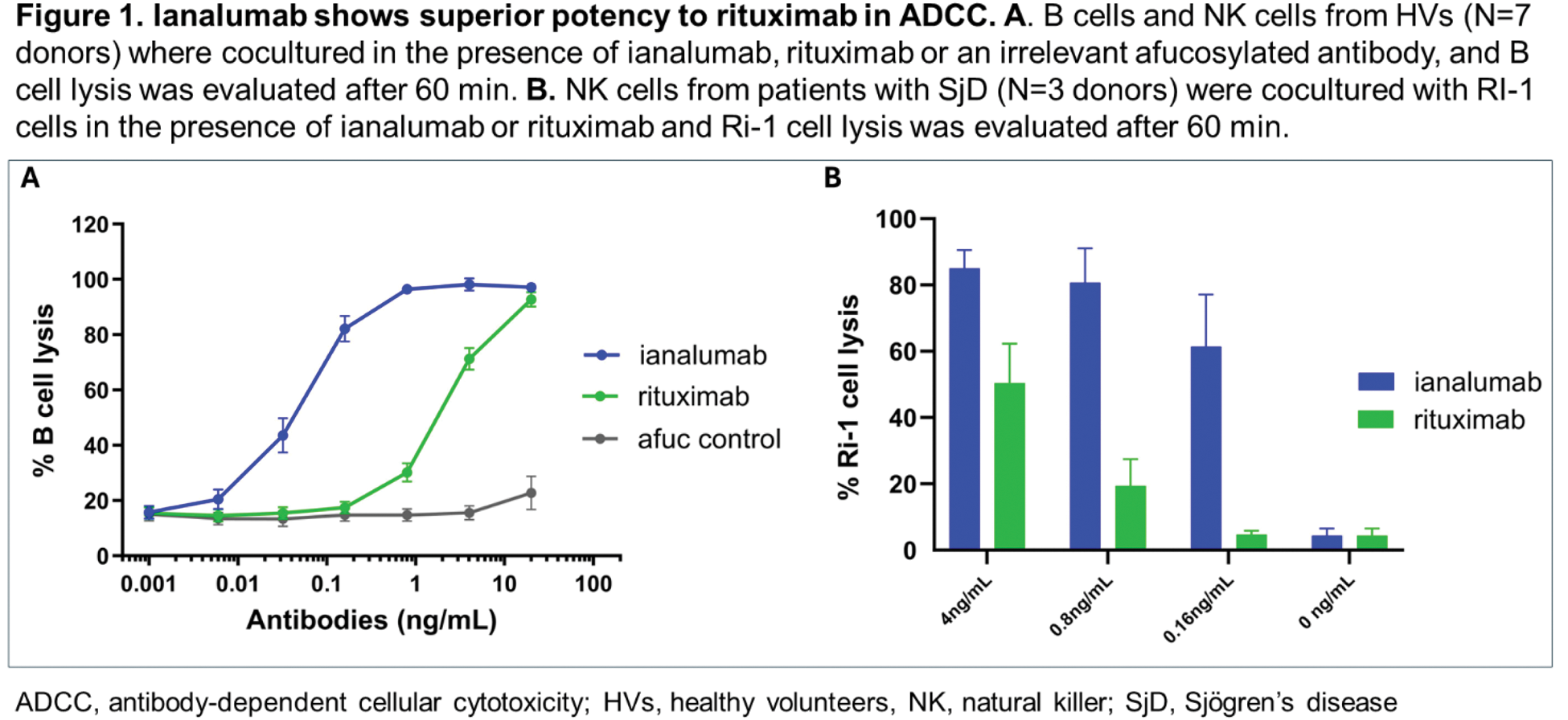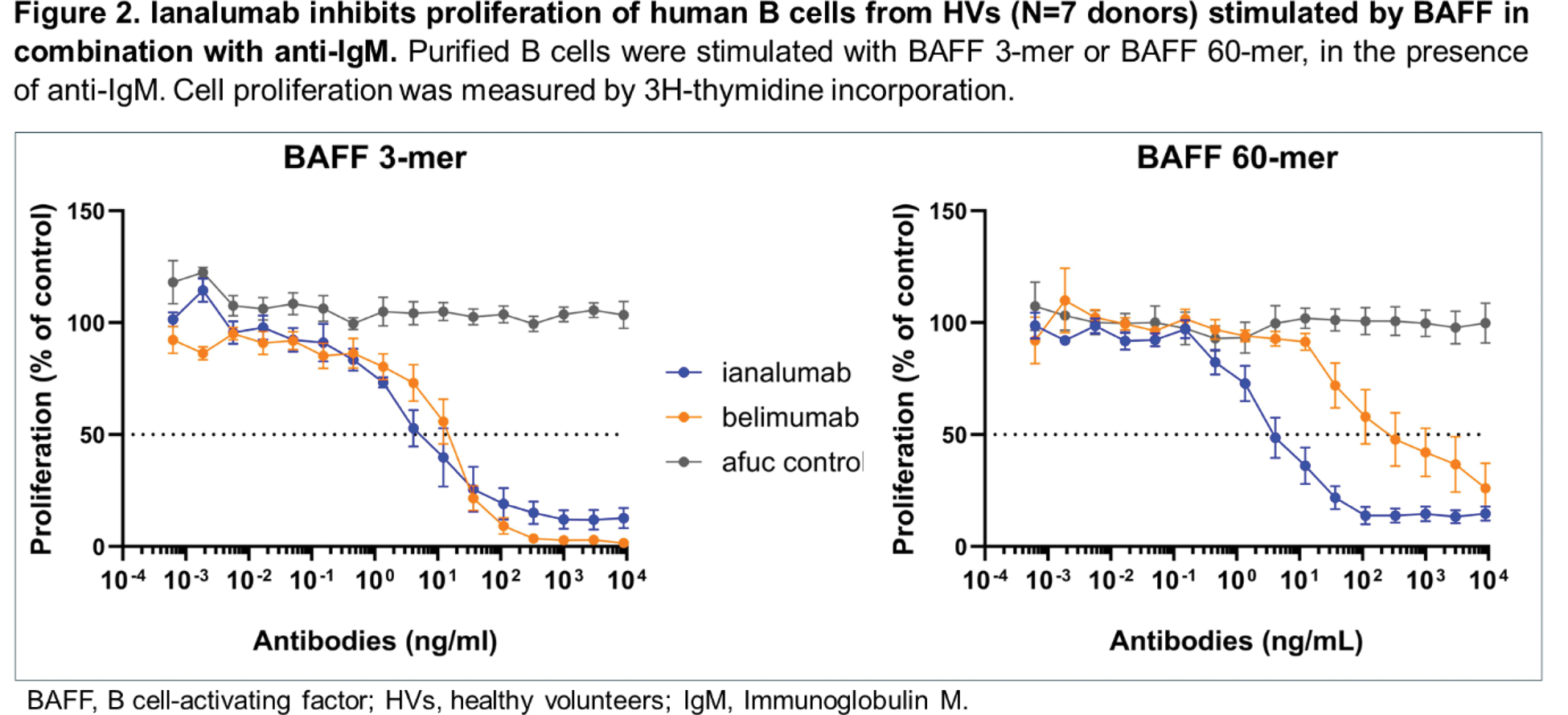

Background: B cells are key players in the pathogenesis of Sjögren’s disease (SjD), systemic lupus erythematosus (SLE) and other systemic auto-immune diseases, supporting B cell depletion as an attractive therapeutic strategy in these patients. However, survival signals mediated by high level of B cell-activating factor (BAFF) may interfere with B cell depletion, as well as drive disease flares. Ianalumab, an investigational afucosylated monoclonal antibody targeting BAFF-receptor (BAFF-R), has been shown to deplete B cells through enhanced antibody-dependent cellular cytotoxicity (ADCC) with concurrent blockade of BAFF:BAFF-R mediated signals [1].
Objectives: To extensively characterise the properties of ianalumab on B cells in vitro, as well as its ability to deplete circulating and tissue B cells in B6 mice and in the spontaneous non-obese diabetic (NOD) mouse model of SjD.
Methods: The binding affinity and specificity of ianalumab were evaluated using Biacore and flow cytometry. In vitro B cell killing was assessed using peripheral blood mononuclear cells or isolated NK cells and B cells from healthy volunteers (HVs) and patients with SjD or SLE. In vitro blockade of BAFF stimulation was evaluated through competition assays with labeled BAFF, Western blots of Nuclear Factor Kappa B Subunit 2 (NF-kB2) intact and cleaved forms, B cell proliferation measured by thymidine incorporation, and quantification of IgG secretion. The efficacy of B cell depletion following administration of ianalumab in B6 and NOD mice was investigated using flow cytometry and/or histology in blood and relevant organs.
Results: Ianalumab demonstrated high affinity and selectivity for BAFF-R. In an ADCC assay co-culturing purified NK cells with B cells from HVs, ianalumab showed a 44-fold increased potency compared to rituximab (Figure 1A). This increased potency was also observed when NK cells from patients with SjD and SLE were tested (Figure 1B). Additionally, ianalumab effectively prevented BAFF from binding to BAFF-R expressing cells. This blockade of BAFF-R on human B cells correlated with effective inhibition of BAFF-induced cleavage of NF-κB2 (p100), proliferation and IgG production. Notably, ianalumab was able to inhibit B cell proliferation with the same potency, when induced by a BAFF trimer or 60-mer (Figure 2). In vivo, ianalumab induced a significant reduction of B cell subpopulations in blood and lymphoid organs of B6 mice. In addition, ianalumab was able to reduce B cells in the salivary glands of NOD mice, showing its ability to reduce B cells in the target organs of mice suffering from systemic autoimmunity.
Conclusion: Ianalumab, through its dual mechanism of action, addresses limitations of first-generation B cell targeting therapies for auto-immune diseases by providing more potent B cell depletion and additional BAFF-R blockade on remaining B cells. Accordingly, patients with SjD (NCT02962895) or SLE (NCT03656562) treated with ianalumab for up to 52 weeks showed sustained reduction in disease activity in phase 2 trials [2, 3]. Ongoing phase 3 studies in SjD, SLE and LN will provide further evidence on the efficacy and safety of ianalumab in larger patient populations.
REFERENCES: [1] McWilliams EM, et al. Blood Adv. 2019;3:447-60.
[2] Shen N, et al. [abstract]. Arthritis Rheumatol. 2023;75 (suppl 9).
[3] Bowman SJ, et al. Lancet. 2022;399:161-71.


Acknowledgements: NIL.
Disclosure of Interests: Catherine Wioland Employee of Novartis, Corinne Vedrine Employee of Novartis, Caroline Walter Employee of Novartis, Fanny Marque Employee of Novartis, Thomas Dannequin Employee of Novartis, Melanie Ceci Employee of Novartis, David Buffet Employee of Novartis, Cindy Schmid Employee of Novartis, Elena Degl’Innocenti Employee of Novartis, Gautier Robert Employee of Novartis, Grazyna Wieczorek Shareholder of Novartis, Employee of Novartis, David Schubert Shareholder of Novartis, Employee of Novartis, Catriona Paape Employee of Novartis, Isabelle Isnardi Shareholder of Novartis, Employee of Novartis.
© The Authors 2025. This abstract is an open access article published in Annals of Rheumatic Diseases under the CC BY-NC-ND license (